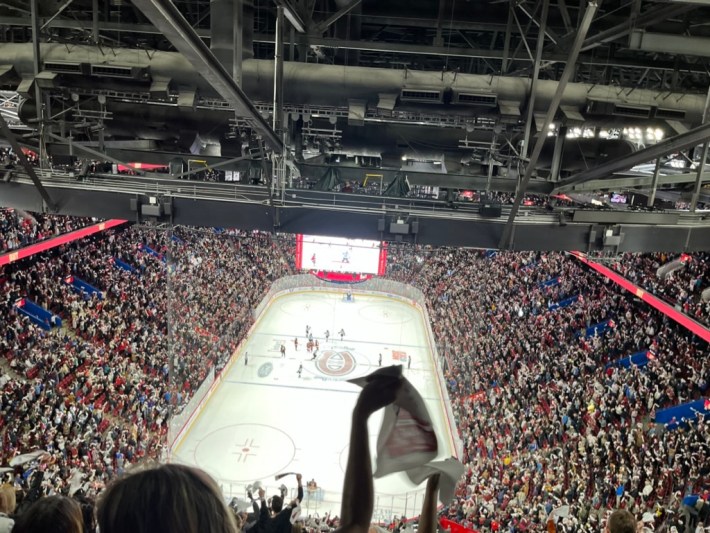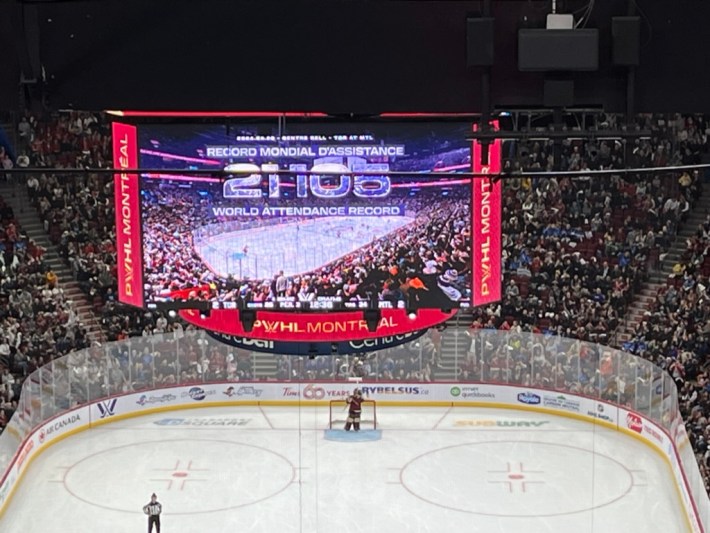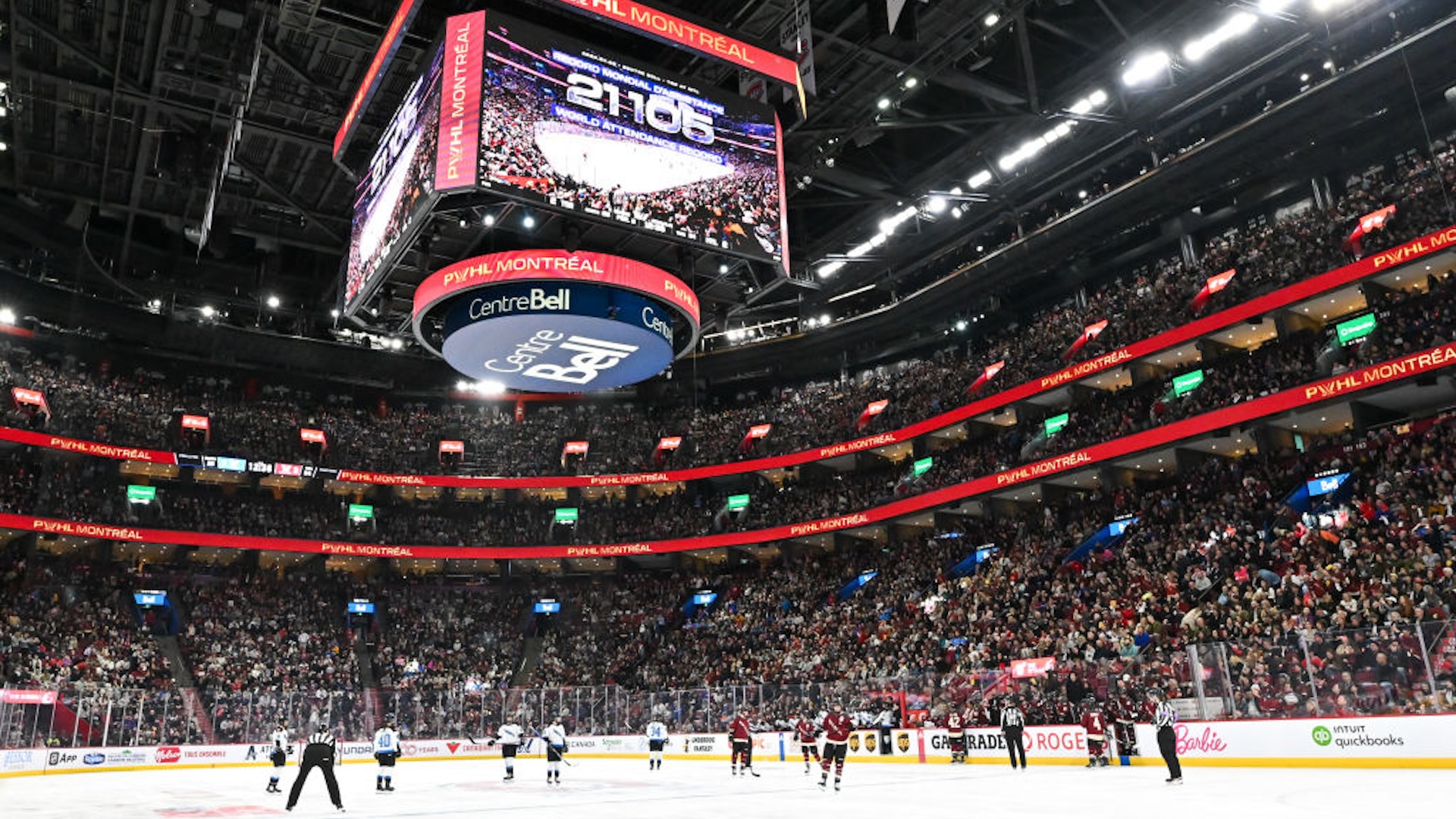MONTREAL — Near the metro stop where I impatiently waited for my friend to find me, there was a group of girls, each about 13 years old. They wore matching bright pink hockey jerseys and were singing and dancing throughout the 15 or so minutes that I was near them. I couldn’t quite make out what the poster they were holding read, but I didn’t have to. They were just a small part of a large crowd that was already streaming toward Centre Bell in Montreal. Like everyone else, they were there to watch a hockey game.
In March, the as-yet-unnamed PWHL Montreal team announced it was moving this game, against Toronto, from the 4,114-seat Verdun Auditorium to Centre Bell, the biggest hockey arena in North America and the second-biggest in the world. When tickets went on sale in April, they sold out in 20 minutes. The same teams had previously set the attendance record in February at Scotiabank Arena in Toronto. But, Montreal being a better city than Toronto, Centre Bell is a bigger arena than Scotiabank, and thus this game's destiny was always to re-break that record.
Before the starting players were announced, a montage of Montreal’s season highlights played on the screen in the darkened arena. It ended with a shot of a kid holding a handmade sign that read “QUAND LE CENTRE BELL?” I would have rolled my eyes from the cheesiness if they weren’t all wet.
Then, the starting players were announced, and you’d have thought they had just come home from war for the reception we gave them. When Marie-Philip Poulin, captain of the Canadian national team and Quebec native, was introduced, the arena’s volume somehow got even louder.
“It got to me,” Poulin said of the ovation after the game. “It gave me chills. It made me emotional, for sure.”
As soon as the game began, Montreal looked menacing. They fired 17 shots on goal in the first period alone, but Toronto goalie Kristen Campbell was impenetrable to start the game. In the 10th minute, Blayre Turnbull scored for Toronto on one of their few attacks. The stands went quiet, then a low booooo gathered steam. Montreal-Toronto rivalries are fun!
The period proceeded much as it had started, until the final minute, when Montreal’s Sarah Bujold scored the equalizer. We jumped, we screamed, we whipped around the little towels they gave us, even as the refs got set for the faceoff, and a little after that. I have never been part of a crowd that cheered for as loud and as long.
In the break between the first two periods, the place was buzzing. It didn’t matter that the arena DJ’s music was way too techno for 2 p.m. on a Saturday, that the PHWL Montreal jerseys countless fans wore looked like they were made by Fanatics, or that the Canadiens’ logo was in the center of the rink, leftover from their game last Tuesday. (Well, the PWHL logo would have been nice, but it’s not like anyone was wishing they were at a Canadiens game instead.) We were there for the hockey, and the hockey was fantastic.

Forty seconds into the second period, however, the hockey did not go our way. Sarah Nurse scored for Toronto, reinstating their lead and shutting up the crowd yet again. The period continued with Montreal generating some good chances but never capitalizing on them. Then, with 26 seconds left, Erin Ambrose leveled it for Montreal.
If Montreal had strategized to put on the most dramatic show possible, they couldn’t have come up with a better formula than this: Go down, push and push without avail, then finally equalize in the dying seconds of the period. Yet again, the crowd went—how do you say it?—fucking insane. Twice we had come back in the dying breath of the period, twice the arena erupted in a riot of thrilling proportions. My throat was hoarse from screaming and my arm felt like Jell-O for how vigorously I was waving my little towel. I had never been happier, or so it felt.
During a break in play in the third period, the in-stadium announcer made the long-awaited declaration that the attendance record was officially broken. Everybody, all 21,105 of us, simply screamed our heads off. Even the players, who had been huddled by their teams’ benches, jostled their sticks in the air in recognition of the moment. If you ever want to feel hopeful about the world, I cannot recommend going to a record-breaking women’s sports game enough.

No one scored in the third period, so regular time ended in a tie, 2-2. My friend scrambled to look up what the PWHL overtime rules are: Five minutes of sudden-death overtime, we learned, followed by a shootout if no one scored. No sooner had we gotten ourselves caught up on the rules than the buzzer sounded to start the period, and in a blink—13 seconds, to be exact—Nurse scored again for Toronto. Sudden death indeed.
The crowd went quiet, yet again. Then, once Toronto was done with their celebration—they had clinched a playoff berth with the win—we cheered, yet again. Losing to Toronto was shit, but the significance of the moment was more than reason enough for joy. In a league that is so new, the latest in a long sequence of attempts at bringing professional women’s hockey to North America, losing a game like that doesn’t feel so bad, not when you’ve just set the world attendance record. I’ve been to two PWHL games now, and both experiences left me feeling that this league is solid. Leagues that sell out Centre Bell don’t fold, right?
In a sense, the record-breaking moment is bittersweet. Centre Bell should just be the normal home stadium for PWHL Montreal, and it should hit capacity many times a season. The only reason it took until 2024 to see a crowd like this at a women’s professional hockey game is due to the lack of investment and infrastructure that has doomed previous leagues. The players and fans have always been there, and what happened on Saturday afternoon was proof of what’s possible when both are given a sturdy platform to stand on.
For those of us that follow women’s sports, the constant discussion of professional female athletes inspiring the next generation and showing that women can do it too can become mind-numbing. I’ll be the first to admit that the obviousness of it all makes me want to drown myself in a pool full of pink goo whenever someone proclaims HERSTORY at the latest Big Moment for women’s sports. But nothing washes away cynicism quite like a great game and a great crowd, and I could only feel joy when the jumbotron cut to kids holding signs that said "2035 PWHL Draft Eligible" and "Now My Dreams Can Come True." A record-breaking crowd is meaningful not for the headlines and momentary surges of attention it brings, but for the link it creates in a chain. Those signs reminded me of what Maitreyi wrote last week, about the generative relationship between the WNBA's past and future:
This is the WNBA working as it should, as a two-way street: Give a 9-year-old Caitlin Clark something to shoot for, and she’ll do her part to get here. She is happening to the WNBA because the WNBA happened to her, and she and the WNBA will happen to someone else, who will also make this league a little bit better and a little more appealing to the next 9-year-old.
21,105 fans bought tickets and watched a hockey game. Odds are that some of them will go on to pick up a stick, and when they do they’ll remember what it felt like to be in an arena full of people screaming their heads off. A moment like that can make the future feel as real as the present. Maybe, in 10 years, a PWHL rookie will get the chance to tell us all how it felt.






